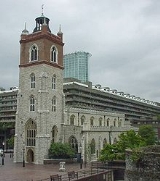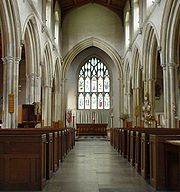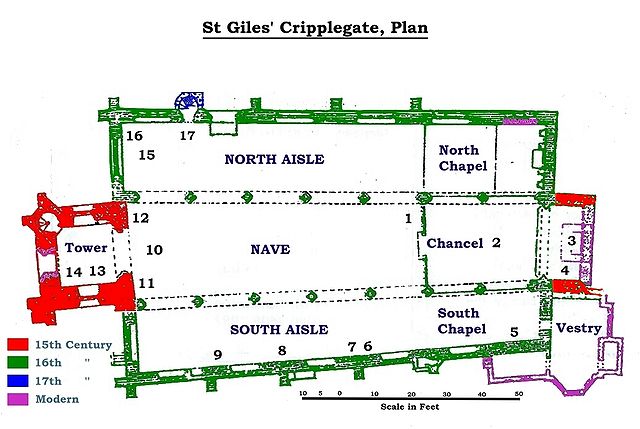
St Giles-without-Cripplegate
Encyclopedia
St Giles-without-Cripplegate is a Church of England
church in the City of London
, located within the modern Barbican complex
. When built it stood without (that is, outside) the city wall
, near the Cripplegate
. The church is dedicated to St Giles
, patron saint
of beggars and cripples. It is one of the few medieval churches left in the City of London, having survived the Great Fire
of 1666.
church on the site in the 11th century but by 1090 it had been replaced by a Norman
one. In 1394 it was rebuilt in the perpendicular gothic style.
The church has been badly damaged by fire on three occasions: In 1545, in 1897 and during an air raid
of the Blitz of the Second World War on the night of 24 August 1940 . German bombs completely gutted the church but it was restored using the plans of the reconstruction of 1545. The stone tower was added in 1682. A new ring of twelve bells was cast by Mears and Stainbank in 1954, and this was augmented with a sharp second bell cast in 2006 by the Whitechapel Bell Foundry
.
The church was designated a Grade I listed building on 4 January 1950.


Church of England
The Church of England is the officially established Christian church in England and the Mother Church of the worldwide Anglican Communion. The church considers itself within the tradition of Western Christianity and dates its formal establishment principally to the mission to England by St...
church in the City of London
City of London
The City of London is a small area within Greater London, England. It is the historic core of London around which the modern conurbation grew and has held city status since time immemorial. The City’s boundaries have remained almost unchanged since the Middle Ages, and it is now only a tiny part of...
, located within the modern Barbican complex
Barbican Estate
The Barbican Estate is a residential estate built during the 1960s and the 1970s in the City of London, in an area once devastated by World War II bombings and today densely populated by financial institutions...
. When built it stood without (that is, outside) the city wall
London Wall
London Wall was the defensive wall first built by the Romans around Londinium, their strategically important port town on the River Thames in what is now the United Kingdom, and subsequently maintained until the 18th century. It is now the name of a road in the City of London running along part of...
, near the Cripplegate
Cripplegate
Cripplegate was a city gate in the London Wall and a name for the region of the City of London outside the gate. The area was almost entirely destroyed by bombing in World War II and today is the site of the Barbican Estate and Barbican Centre...
. The church is dedicated to St Giles
Saint Giles
Saint Giles was a Greek Christian hermit saint from Athens, whose legend is centered in Provence and Septimania. The tomb in the abbey Giles was said to have founded, in St-Gilles-du-Gard, became a place of pilgrimage and a stop on the road that led from Arles to Santiago de Compostela, the...
, patron saint
Patron saint
A patron saint is a saint who is regarded as the intercessor and advocate in heaven of a nation, place, craft, activity, class, clan, family, or person...
of beggars and cripples. It is one of the few medieval churches left in the City of London, having survived the Great Fire
Great Fire of London
The Great Fire of London was a major conflagration that swept through the central parts of the English city of London, from Sunday, 2 September to Wednesday, 5 September 1666. The fire gutted the medieval City of London inside the old Roman City Wall...
of 1666.
History
There was a SaxonAnglo-Saxons
Anglo-Saxon is a term used by historians to designate the Germanic tribes who invaded and settled the south and east of Great Britain beginning in the early 5th century AD, and the period from their creation of the English nation to the Norman conquest. The Anglo-Saxon Era denotes the period of...
church on the site in the 11th century but by 1090 it had been replaced by a Norman
Normans
The Normans were the people who gave their name to Normandy, a region in northern France. They were descended from Norse Viking conquerors of the territory and the native population of Frankish and Gallo-Roman stock...
one. In 1394 it was rebuilt in the perpendicular gothic style.
The church has been badly damaged by fire on three occasions: In 1545, in 1897 and during an air raid
Strategic bombing
Strategic bombing is a military strategy used in a total war with the goal of defeating an enemy nation-state by destroying its economic ability and public will to wage war rather than destroying its land or naval forces...
of the Blitz of the Second World War on the night of 24 August 1940 . German bombs completely gutted the church but it was restored using the plans of the reconstruction of 1545. The stone tower was added in 1682. A new ring of twelve bells was cast by Mears and Stainbank in 1954, and this was augmented with a sharp second bell cast in 2006 by the Whitechapel Bell Foundry
Whitechapel Bell Foundry
The Whitechapel Bell Foundry is a bell foundry in Whitechapel in the London Borough of Tower Hamlets, in the East End of London. The foundry is listed by the Guinness Book of Records as the oldest manufacturing company in Great Britain...
.
The church was designated a Grade I listed building on 4 January 1950.
Notable people associated with the church

- John FieldJohn Field (divine)John Feild , also called John Feilde, was a British Puritan clergyman and controversialist.-Life:We know very little of his early life, but when he was ordained by Edmund Grindal in 1566 at the age of 21, he was called a bachelor of arts of Christ Church, Oxford...
, curate of the church, c. 1570 - John FoxeJohn FoxeJohn Foxe was an English historian and martyrologist, the author of what is popularly known as Foxe's Book of Martyrs, , an account of Christian martyrs throughout Western history but emphasizing the sufferings of English Protestants and proto-Protestants from the fourteenth century through the...
, author of the Book of MartyrsFoxe's Book of MartyrsThe Book of Martyrs, by John Foxe, more accurately Acts and Monuments, is an account from a Protestant point of view of Christian church history and martyrology...
, surrogate for Crowley c. 1565 and buried in the church, 1587 - Robert Crowley, rector of St Giles's, friend of Foxe, printer, poet, social gospeller, and Protestant polemicist, buried in the church, 1588
- Lancelot AndrewesLancelot AndrewesLancelot Andrewes was an English bishop and scholar, who held high positions in the Church of England during the reigns of Queen Elizabeth I and King James I. During the latter's reign, Andrewes served successively as Bishop of Chichester, Ely and Winchester and oversaw the translation of the...
, rector of the church after Crowley - Sir Martin FrobisherMartin FrobisherSir Martin Frobisher was an English seaman who made three voyages to the New World to look for the Northwest Passage...
, captain who fought against the Spanish ArmadaSpanish ArmadaThis article refers to the Battle of Gravelines, for the modern navy of Spain, see Spanish NavyThe Spanish Armada was the Spanish fleet that sailed against England under the command of the Duke of Medina Sidonia in 1588, with the intention of overthrowing Elizabeth I of England to stop English...
, buried in the church, 1594 - Nathaniel EatonNathaniel EatonNathaniel Eaton was the first schoolmaster of Harvard College in Cambridge, Massachusetts, and later became a clergyman.- Biography :...
, first schoolmaster of Harvard CollegeHarvard CollegeHarvard College, in Cambridge, Massachusetts, is one of two schools within Harvard University granting undergraduate degrees...
, christened, 1610 - Oliver CromwellOliver CromwellOliver Cromwell was an English military and political leader who overthrew the English monarchy and temporarily turned England into a republican Commonwealth, and served as Lord Protector of England, Scotland, and Ireland....
, military commander and Lord ProtectorLord ProtectorLord Protector is a title used in British constitutional law for certain heads of state at different periods of history. It is also a particular title for the British Heads of State in respect to the established church...
of England during the CommonwealthCommonwealth of EnglandThe Commonwealth of England was the republic which ruled first England, and then Ireland and Scotland from 1649 to 1660. Between 1653–1659 it was known as the Commonwealth of England, Scotland and Ireland...
, married in the church, 1620 - Nicholas TooleyNicholas TooleyNicholas Tooley was a Renaissance actor in the King's Men, the acting company of William Shakespeare.Recent research has shown that Tooley was born in late 1582 or early 1583; his birth name was not Tooley but Wilkinson...
, Shakespearean Actor, Sharer of Globe Theatre Buried 5 June 1623 - John SpeedJohn SpeedJohn Speed was an English historian and cartographer.-Life:He was born at Farndon, Cheshire, and went into his father's tailoring business where he worked until he was about 50...
, author of the Theatre of the Empire of Great Britaine, buried in the church, 1629 - John MiltonJohn MiltonJohn Milton was an English poet, polemicist, a scholarly man of letters, and a civil servant for the Commonwealth of England under Oliver Cromwell...
, author of Paradise LostParadise LostParadise Lost is an epic poem in blank verse by the 17th-century English poet John Milton. It was originally published in 1667 in ten books, with a total of over ten thousand individual lines of verse...
, buried in the church, 1674 - John BunyanJohn BunyanJohn Bunyan was an English Christian writer and preacher, famous for writing The Pilgrim's Progress. Though he was a Reformed Baptist, in the Church of England he is remembered with a Lesser Festival on 30 August, and on the liturgical calendar of the Episcopal Church on 29 August.-Life:In 1628,...
, author of Pilgrim's ProgressThe Pilgrim's ProgressThe Pilgrim's Progress from This World to That Which Is to Come is a Christian allegory written by John Bunyan and published in February, 1678. It is regarded as one of the most significant works of religious English literature, has been translated into more than 200 languages, and has never been...
, attended the church - Daniel DefoeDaniel DefoeDaniel Defoe , born Daniel Foe, was an English trader, writer, journalist, and pamphleteer, who gained fame for his novel Robinson Crusoe. Defoe is notable for being one of the earliest proponents of the novel, as he helped to popularise the form in Britain and along with others such as Richardson,...
, author of Robinson CrusoeRobinson CrusoeRobinson Crusoe is a novel by Daniel Defoe that was first published in 1719. Epistolary, confessional, and didactic in form, the book is a fictional autobiography of the title character—a castaway who spends 28 years on a remote tropical island near Trinidad, encountering cannibals, captives, and...
, died in the parish, 1731 - Rick WakemanRick WakemanRichard Christopher Wakeman is an English keyboard player, composer and songwriter best known for being the former keyboardist in the progressive rock band Yes...
, keyboardist who recorded his track "Jane Seymour" at the church, and who inadvertently contributed £2000 to the church's upkeep. - Roger Townshend was buried in the church in 1590.
Layout of the Church

- 1. John Milton buried here in 1674
- 2. The altar from St. Luke's, Old StreetSt Luke Old Street (church)St Luke is a historic Anglican church building in the London Borough of Islington. It is now a music centre operated by the London Symphony Orchestra and known as LSO St Luke's. It is the home of the LSO's community and music education programme LSO Discovery...
which was dismantled in the 1960s due to subsidence. - 3. The east window. Designed by the Nicholson Studios, following the pattern of the original medieval window.
- 4. SediliaSediliaSedilia , in ecclesiastical architecture, is the term used to describe stone seats, usually to be found on the south side of an altar, often in the chancel, for the use of the officiating priests...
(where the priest sat and piscinaPiscinaA piscina is a shallow basin placed near the altar of a church, used for washing the communion vessels. The sacrarium is the drain itself. Anglicans usually refer to the basin, calling it a piscina. Roman Catholics usually refer to the drain, and by extension, the basin, as the sacrarium...
of the medieval church. - 5. Display cabinet containing the historic treasures of Cripplegate.
- 6. John Foxe, author of "The Book of Martyrs" is buried here.
- 7. Plaque commemorating Sir Martin Frobisher, explorer and sea Captain.
- 8. Bust of John Speed, map maker and historian.
- 9. Statue of John Milton by Horace Montford
- 10. The organ. From St. Luke's, Old Street
- 11. Bust of Daniel Defoe, author of "Robinson Crusoe" and John Milton.
- 12. Busts of Oliver Cromwell and John Bunyan, author of "Pilgrims Progress".
- 13. Portrait of Dr. William Nicholls, the first Rector of St. Luke's Church and Vicar of St. Giles'.
- 14. The West Window - shows the coats of arms of the Archbishop of Canterbury, the Bishop of London, Milton, Cromwell and Frobisher.
- 15. The font - from St. Luke's Church.
- 16. The Cripplegate Window which celebrates the centenary of the charity The Cripplegate Foundation.
- 17. Bust of Sir William Staines, Lord Mayor of London in 1801.

